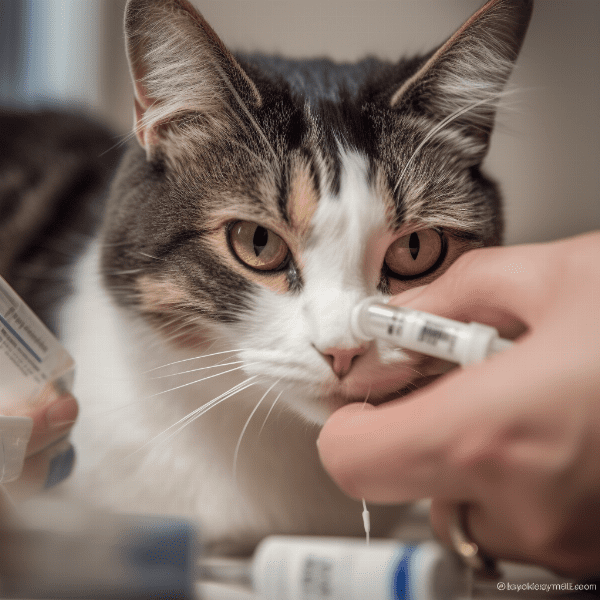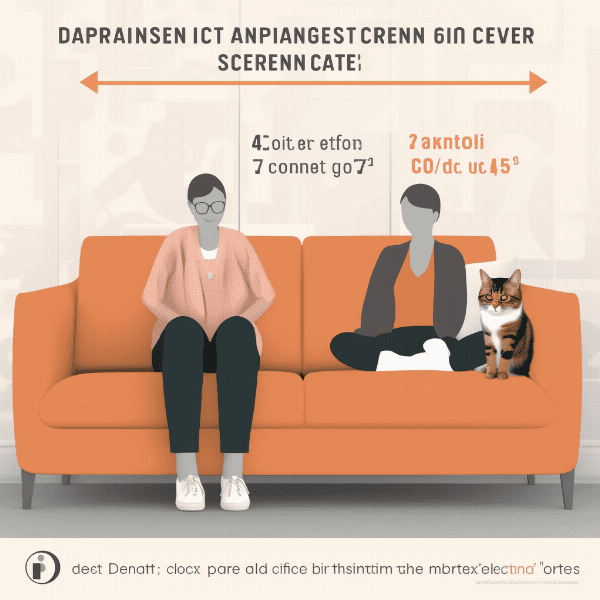Table of Contents
- Understanding Diabetic Neuropathy in Cats
- Causes of Feline Diabetic Neuropathy
- Recognizing Symptoms of Diabetic Neuropathy in Cats
- Diagnostic Tests for Feline Diabetic Neuropathy
- Treatment Options for Feline Diabetic Neuropathy
- Managing Feline Diabetic Neuropathy at Home
- Prevention of Feline Diabetic Neuropathy
- When to Seek Veterinary Care for Feline Diabetic Neuropathy
- Prognosis and Long-term Outlook for Cats with Diabetic Neuropathy
- Supporting Your Cat Through Diabetic Neuropathy Recovery
Understanding Diabetic Neuropathy in Cats
Feline diabetic neuropathy is a complication that arises in cats with uncontrolled diabetes. This condition affects the peripheral nerves that transmit signals from the brain and spinal cord to the rest of the body. When these nerves are damaged, cats may experience pain, weakness, and difficulty coordinating their movements.
How Does Diabetic Neuropathy Develop in Cats?
Diabetic neuropathy in cats develops over time as a result of prolonged high blood sugar levels. As blood sugar levels remain elevated, they can cause damage to the small blood vessels that supply the nerves with oxygen and nutrients. This can lead to nerve damage, particularly in the legs and feet, where the nerves are longest.
Types of Diabetic Neuropathy in Cats
There are several types of diabetic neuropathy that can affect cats, including:
- Sensory neuropathy: This type of neuropathy affects the cat’s ability to feel sensations in their paws and legs.
- Motor neuropathy: This type of neuropathy affects the cat’s ability to move their legs and can cause weakness or paralysis.
- Autonomic neuropathy: This type of neuropathy affects the automatic functions of the body, such as digestion, urination, and breathing.
Risk Factors for Feline Diabetic Neuropathy
Certain factors increase a cat’s risk of developing diabetic neuropathy. These include:
- Uncontrolled diabetes: Cats whose blood sugar levels remain elevated for long periods are more likely to develop neuropathy.
- Obesity: Overweight cats are at a higher risk of developing diabetes and diabetic neuropathy.
- Age: Older cats are more likely to develop diabetes and diabetic neuropathy.
- Gender: Male cats are more likely to develop diabetes and diabetic neuropathy than females.
Symptoms of Diabetic Neuropathy in Cats
The symptoms of diabetic neuropathy in cats may vary depending on the type and severity of the neuropathy. Some common symptoms include:
- Difficulty walking or standing
- Loss of balance and coordination
- Weakness in the legs
- Pain or sensitivity in the legs and paws
- Loss of muscle tone
- Urinary incontinence
- Constipation or diarrhea
Conclusion
Diabetic neuropathy is a serious complication that can develop in cats with uncontrolled diabetes. Understanding the causes, types, and risk factors of this condition can help cat owners recognize the signs of neuropathy and seek appropriate veterinary care.

Causes of Feline Diabetic Neuropathy
Feline diabetic neuropathy is caused by prolonged high blood sugar levels, which damage the small blood vessels that supply the nerves with oxygen and nutrients. This damage can lead to nerve dysfunction and eventually neuropathy. However, there are other factors that may contribute to the development of diabetic neuropathy in cats.
Genetic Factors
Research suggests that genetic factors may play a role in the development of feline diabetic neuropathy. Some breeds, such as Burmese cats, are more predisposed to developing diabetes and its complications, including neuropathy.
Obesity
Obesity is a known risk factor for diabetes and its complications, including neuropathy. Excess weight can cause insulin resistance, a condition where the body becomes less responsive to insulin, leading to high blood sugar levels and nerve damage.
Chronic Inflammation
Chronic inflammation is a common feature of diabetes and its complications, including neuropathy. Inflammation can cause oxidative stress, a process that damages cells and tissues, including nerves.
Poor Blood Sugar Control
Poor blood sugar control is the primary cause of feline diabetic neuropathy. When blood sugar levels remain elevated for prolonged periods, they can cause damage to the blood vessels that supply the nerves, leading to nerve dysfunction and eventually neuropathy.
Other Health Conditions
Other health conditions, such as hyperthyroidism, kidney disease, and pancreatic disease, can increase a cat’s risk of developing diabetes and its complications, including neuropathy.
Conclusion
Feline diabetic neuropathy is primarily caused by prolonged high blood sugar levels, which damage the nerves that transmit signals from the brain and spinal cord to the rest of the body. However, genetic factors, obesity, chronic inflammation, poor blood sugar control, and other health conditions may also contribute to the development of this condition. Understanding the causes of feline diabetic neuropathy can help cat owners prevent the condition or seek appropriate veterinary care.

Recognizing Symptoms of Diabetic Neuropathy in Cats
Recognizing the symptoms of feline diabetic neuropathy is crucial for early diagnosis and treatment. While the symptoms may vary depending on the type and severity of neuropathy, there are some common signs to look out for.
Changes in Gait
One of the most noticeable symptoms of diabetic neuropathy in cats is a change in gait. Cats with neuropathy may walk with a wobbly gait or drag their paws on the ground. They may also have difficulty jumping, climbing, or walking up stairs.
Loss of Balance and Coordination
Cats with diabetic neuropathy may have difficulty maintaining their balance and coordination. They may stumble, fall, or have trouble standing up after lying down.
Muscle Weakness
Diabetic neuropathy can cause muscle weakness in cats, particularly in the hind legs. Cats may have trouble standing up, climbing stairs, or jumping onto furniture.
Pain or Sensitivity
Some cats with diabetic neuropathy may experience pain or sensitivity in their legs and paws. They may also lick or chew their paws excessively due to discomfort.
Urinary and Bowel Problems
Diabetic neuropathy can affect the nerves that control the bladder and bowel, leading to urinary or bowel incontinence or constipation.
Behavioral Changes
Cats with diabetic neuropathy may become irritable, withdrawn, or less active due to pain or discomfort.
Conclusion
Feline diabetic neuropathy can cause a range of symptoms that may vary depending on the type and severity of neuropathy. Changes in gait, loss of balance and coordination, muscle weakness, pain or sensitivity, urinary and bowel problems, and behavioral changes are some common signs of diabetic neuropathy in cats. If you notice any of these symptoms in your cat, it’s important to seek veterinary care for a proper diagnosis and treatment plan.

Diagnostic Tests for Feline Diabetic Neuropathy
Diagnosing feline diabetic neuropathy typically involves a combination of physical examination, medical history, and diagnostic tests. Your veterinarian may perform several tests to confirm the presence of neuropathy and determine the severity of the condition.
Physical Examination
During a physical examination, your veterinarian will check your cat’s gait, reflexes, muscle tone, and overall physical condition. They may also perform a neurological exam to assess nerve function and look for signs of neuropathy.
Medical History
Your veterinarian will take a detailed medical history to gather information about your cat’s diet, lifestyle, and medical conditions. This information can help identify any underlying conditions that may contribute to the development of neuropathy.
Blood Tests
Blood tests are an essential tool for diagnosing feline diabetic neuropathy. Your veterinarian may perform blood glucose tests to determine your cat’s blood sugar levels and assess their diabetes management. They may also perform a complete blood count and serum biochemistry tests to evaluate your cat’s overall health.
Nerve Conduction Studies
Nerve conduction studies measure the speed and strength of the nerve signals in your cat’s body. These tests can help determine the extent and severity of nerve damage in cats with diabetic neuropathy.
Electromyography
Electromyography is a diagnostic test that measures the electrical activity of muscles. This test can help evaluate muscle function and identify any abnormalities that may be contributing to neuropathy.
Imaging Tests
In some cases, your veterinarian may recommend imaging tests, such as X-rays, ultrasound, or magnetic resonance imaging (MRI), to evaluate your cat’s nerve function and identify any structural abnormalities that may be causing neuropathy.
Conclusion
Diagnosing feline diabetic neuropathy involves a comprehensive evaluation of your cat’s medical history, physical examination, and diagnostic tests. Blood tests, nerve conduction studies, electromyography, and imaging tests are valuable tools that can help confirm the presence of neuropathy and determine the severity of the condition. If you suspect your cat has diabetic neuropathy, it’s essential to seek veterinary care for a proper diagnosis and treatment plan.

Treatment Options for Feline Diabetic Neuropathy
Feline diabetic neuropathy is a treatable condition, and early intervention can help prevent the progression of the disease. The treatment plan for diabetic neuropathy in cats may include a combination of medical and supportive therapies.
Medical Therapies
The primary goal of medical therapy for feline diabetic neuropathy is to manage diabetes and control blood sugar levels. Your veterinarian may recommend insulin therapy, dietary modifications, and weight management to help manage diabetes and prevent further nerve damage.
Supportive Therapies
Supportive therapies can help alleviate the symptoms of diabetic neuropathy and improve your cat’s quality of life. These therapies may include:
- Pain management: Your veterinarian may prescribe pain medications or recommend alternative therapies, such as acupuncture or laser therapy, to manage pain and discomfort.
- Physical therapy: Physical therapy can help improve muscle tone and strength, enhance range of motion, and improve balance and coordination.
- Assisted mobility: Assisted mobility devices, such as carts or slings, can help cats with severe neuropathy move around more easily.
Lifestyle Modifications
Lifestyle modifications can also play a crucial role in managing feline diabetic neuropathy. These may include:
- Regular exercise: Exercise can help improve muscle tone and strength and enhance mobility.
- Weight management: Maintaining a healthy weight can help prevent diabetes and its complications, including neuropathy.
- Environmental modifications: Making changes to your cat’s environment, such as adding ramps or removing obstacles, can help improve mobility and prevent falls.
Conclusion
Feline diabetic neuropathy is a treatable condition, and early intervention can help prevent the progression of the disease. The treatment plan for diabetic neuropathy in cats may include a combination of medical and supportive therapies, as well as lifestyle modifications. If your cat has been diagnosed with diabetic neuropathy, it’s essential to work closely with your veterinarian to develop an individualized treatment plan that meets your cat’s specific needs.

Managing Feline Diabetic Neuropathy at Home
Managing feline diabetic neuropathy at home is an essential part of your cat’s treatment plan. By providing your cat with proper care and support, you can help alleviate the symptoms of neuropathy and improve their quality of life.
Medication Administration
If your cat is receiving medication for diabetes or pain management, it’s important to follow your veterinarian’s instructions for medication administration carefully. You may need to administer insulin injections, pain medications, or other medications at home.
Environmental Modifications
Modifying your cat’s environment can help improve their mobility and prevent falls. You can make changes such as providing ramps, removing obstacles, and using nonslip flooring to help your cat move around more easily.
Conclusion
Managing feline diabetic neuropathy at home requires a combination of proper medication administration, environmental modifications, diet and nutrition, exercise and physical therapy, and monitoring of symptoms. By working closely with your veterinarian and providing your cat with the care and support they need, you can help alleviate the symptoms of neuropathy and improve their quality of life.

Prevention of Feline Diabetic Neuropathy
Preventing feline diabetic neuropathy involves managing diabetes and controlling blood sugar levels. There are several steps cat owners can take to prevent the development of neuropathy in their cats.
Regular Veterinary Checkups
Regular veterinary checkups are crucial for maintaining your cat’s health and preventing the development of diabetes and its complications, including neuropathy. Your veterinarian can monitor your cat’s blood sugar levels, evaluate their overall health, and provide guidance on diabetes management.
Weight Management
Maintaining a healthy weight is crucial for preventing diabetes and its complications. Overweight cats are at a higher risk of developing diabetes and neuropathy, so weight management is an important aspect of prevention.
Medication Management
If your cat has been diagnosed with diabetes, it’s important to manage their medication carefully to prevent complications such as neuropathy. Administering insulin and other medications according to your veterinarian’s instructions can help maintain healthy blood sugar levels and prevent nerve damage.
Conclusion
Preventing feline diabetic neuropathy involves managing diabetes and controlling blood sugar levels through regular veterinary checkups, proper diet and nutrition, weight management, exercise and physical activity, and medication management. By taking these steps, cat owners can help prevent the development of neuropathy and ensure their cat’s overall health and well-being.

When to Seek Veterinary Care for Feline Diabetic Neuropathy
Feline diabetic neuropathy is a serious condition that requires prompt veterinary care. If you notice any symptoms of neuropathy in your cat, it’s important to seek veterinary care right away.
Symptoms of Diabetic Neuropathy
Common symptoms of feline diabetic neuropathy include changes in gait, loss of balance and coordination, muscle weakness, pain or sensitivity, urinary and bowel problems, and behavioral changes. If you notice any of these symptoms in your cat, it’s essential to seek veterinary care.
Diagnosis and Treatment
Diagnosing feline diabetic neuropathy typically involves a combination of physical examination, medical history, and diagnostic tests. Once diagnosed, your veterinarian will work with you to develop a treatment plan that may include medical and supportive therapies, as well as lifestyle modifications.
Importance of Early Intervention
Early intervention is crucial for managing feline diabetic neuropathy and preventing the progression of the disease. Delaying veterinary care can lead to further nerve damage and make treatment more challenging.
Conclusion
Feline diabetic neuropathy is a serious condition that requires prompt veterinary care. If you notice any symptoms of neuropathy in your cat, it’s essential to seek veterinary care right away. Diagnosing and treating feline diabetic neuropathy early can help prevent the progression of the disease and improve your cat’s quality of life.

Prognosis and Long-term Outlook for Cats with Diabetic Neuropathy
The prognosis for cats with diabetic neuropathy varies depending on the severity of the condition and the effectiveness of treatment. While diabetic neuropathy is a serious condition, early intervention can help prevent the progression of the disease and improve long-term outlook.
Prognosis
The prognosis for cats with diabetic neuropathy depends on several factors, including the severity of the condition, the duration of diabetes, and the presence of other health conditions. Cats with severe neuropathy may experience permanent nerve damage and long-term complications, while those with milder cases may experience improvement with proper treatment.
Long-term Outlook
With proper management and treatment, cats with diabetic neuropathy can have a good long-term outlook. Medical and supportive therapies, such as insulin therapy, pain management, physical therapy, and lifestyle modifications, can help alleviate the symptoms of neuropathy and improve your cat’s quality of life.
Prevention of Complications
Preventing complications is a crucial aspect of managing diabetic neuropathy in cats. Cats with diabetes are at a higher risk of developing neuropathy and other complications, such as kidney disease, blindness, and infections. Proper diabetes management, including regular veterinary checkups, medication management, and lifestyle modifications, can help prevent the development of complications and ensure your cat’s overall health and well-being.
Conclusion
The prognosis and long-term outlook for cats with diabetic neuropathy depend on several factors, including the severity of the condition and the effectiveness of treatment. With proper management and treatment, cats with neuropathy can have a good long-term outlook and prevent the development of complications. If you suspect your cat has diabetic neuropathy, it’s important to seek veterinary care right away to develop an individualized treatment plan and ensure the best possible outcome.

Supporting Your Cat Through Diabetic Neuropathy Recovery
Recovering from feline diabetic neuropathy can be a long process, but with proper care and support, you can help your cat improve their quality of life and prevent the progression of the disease.
Providing Comfort and Support
Cats with diabetic neuropathy may experience pain, discomfort, and loss of coordination, making it essential to provide them with comfort and support. You can provide soft bedding, use supportive devices such as slings or carts, and make environmental modifications to help your cat move around more easily.
Proper Medication Management
Proper medication management is crucial for managing diabetes and preventing the progression of neuropathy. You should follow your veterinarian’s instructions carefully and administer medications on time to ensure their effectiveness.
Encouraging Exercise and Physical Activity
Regular exercise and physical activity can help improve muscle tone and strength, enhance mobility, and prevent obesity, which can increase the risk of diabetes and neuropathy. You can work with your veterinarian to develop an exercise plan that meets your cat’s needs and abilities.
Nutritious Diet
Proper diet and nutrition are crucial for managing diabetes and preventing the development of neuropathy. A balanced diet that is high in protein and low in carbohydrates can help maintain healthy blood sugar levels and prevent diabetes.
Monitoring Symptoms
Monitoring your cat’s symptoms is an essential part of supporting their recovery from diabetic neuropathy. You should observe your cat for any changes in gait, coordination, muscle strength, or behavior and report any concerns to your veterinarian.
Conclusion
Recovering from feline diabetic neuropathy requires proper care and support. Providing comfort and support, proper medication management, encouraging exercise and physical activity, nutritious diet, and monitoring symptoms are essential for helping your cat recover and improve their quality of life. If you suspect your cat has diabetic neuropathy, it’s important to seek veterinary care right away to develop an individualized treatment plan and ensure the best possible outcome.




